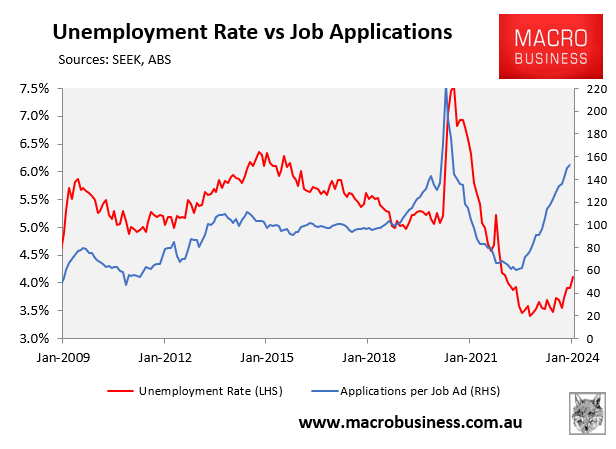Westpac with the note.
While wages may have risen as expect, they were supported by stonger wage outcomes from public sector wages, via enterprise bargaining, while wages more closely tied to economic activity, individual agreements, moderated.
The Wage Price Index (WPI) increased 0.9% over the December quarter to be 4.2% higher in annual terms – the strongest since the mining boom in 2009. The quarterly outcome was consistent with average growth over the past year. Public sector wages led the way, up 1.3% over the quarter, the strongest since December 2008. Private sector wages moderated to 0.9%.
While the headline read was solid, looking at the detail provides further evidence that the labour market is slowing. Firstly, the public sector outperformed. Wages in the public sector are mainly determined by enterprise agreements – these take time to update, negotiate and come into effect. As such, they reflect previous strength in the labour market and policy changes. Wages in sectors where activity is more closely tied to current conditions continue to moderate.
Secondly, bonuses which were once important to attract and keep staff in a tight market are no longer prevalent. In fact, wages growth including bonuses was lower than wages growth excluding bonuses, for the first time since COVID. Finally, the share of private sector employees receiving pay rises was down from a year ago, also pointing to a softening in conditions.
Looking forward, the recent fall in hours worked points to a softening in wages growth. Historically, when growth in hours has been below trend of around 1.5% per annum, resulting in rising underemployment, wages growth tends to moderate to be below 3.5%. This is consistent with our outlook that has wages stepping down to 3.2% by the end of 2024.
Wages growth of 3.5% is consistent with the Reserve Bank’s (RBA) inflation target, provided productivity returns to average, which we are confident will happen as capital catches up to hours worked. So where does this leave the RBA? Today’s numbers are consistent with our view that the next cash rate move is down and that this will occur in September.
The RBA outlook is for 3.7% wage growth at the end of 2024, a full 0.5% higher than Westpac.
Indeed, the delusional RBA doesn’t see wage growth at 3.2% until mid-2026!
Westpac is much closer to the truth because it is not so squeamish about the effects of mass immigration:

Whereas the RBA is intellectually bankrupt.

